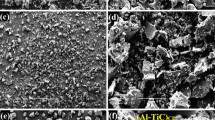Conclusions
-
1.
Additions of Ti, Y, Zr, and Mg lead to even distribution of particles of hardening phase (ZrO2, Al2O3, HfO2) in a Nichrome matrix (Kh20N80) in the production of cast composite material.
-
2.
Additions of these elements lead to an increase in the microhardness of the dispersion-hardened composite, which is explained by the increase in the “assimilation“ of the hardening phase by the matrix and its more even distribution in the matrix.
Similar content being viewed by others
Literature cited
V. I. Nizhenko and V. N. Eremenko, “Role of surface phenomena in PM processes,” in: Surface Phenomena in Metallurgical Processes [in Russian], Metallurgizdat, Moscow (1963), p. 35.
Additional information
I. P. Bardin Central Scientific-Research Institute of Ferrous Metallurgy. Translated from Metallovedenie i Termicheskaya Obrabotka Metallov, No. 11, pp. 35–36, November, 1975.
Rights and permissions
About this article
Cite this article
Kireev, V.B., Abramov, O.V. & Abramov, I.V. Effect of Ti, Y, Zr, and Mg additions on the structure of ingots of dispersion-hardened nichrome. Met Sci Heat Treat 17, 941–942 (1975). https://doi.org/10.1007/BF00679384
Issue Date:
DOI: https://doi.org/10.1007/BF00679384




